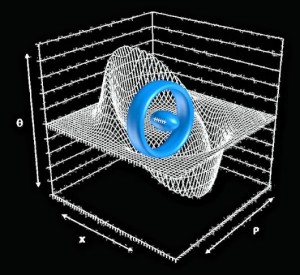NASA’s concept for a warp drive equipped spaceship, the IXS Enterprise. Unfortunately for the moment it’s just daydreaming.
In this post let’s leave ASPS at its researches and have a look at the most famous space agency of the planet: what is it doing for reaching the stars?
Well, it’s watching Star Trek…
In this famous sci-fi series mankind travel among stars thanks to warp propulsion. According to this fictional technology a spaceship is enclosed in a stable space-time bubble, while outside the space is compressed in front of the ship and expanded behind. The ship doesn’t even move, it is the space itself that transport it toward the destination. To simplify this concept we can imagine an ant that is walking on a rubber band stretched between two nails: normally the ant must cover the entire length of the rubber to reach the other side but if we reduce the tension of the rubber by getting it close to the destination nail the ant will be closer to its goal and it will have to cover a much shorter distance.
The hypothetical warp field
While physics was advancing, the screenwriters of Star Trek were drawing from it with both hands , inventing over time more and more detailed explanations that were, all things considered, believable. They’ve been so good at it that warp drive has become subject of research of the official science. In 1994, Mexican physicist Miguel Alcubierre elaborated a theoretical model that aims to create a warp bubble by applying the modern scientific knowledge. On paper, the warp equation works, however there is a small setback before making it real: in order to deform space-time and move a ship at ten times the speed of light the amount of fuel required is equal to Jupiter mass. Quite unpractical, isn’t it? This means that Alcubierre’s equations, though fascinating, probably will remain a mathematical pastime for a long time.
Still, there is who believes in the feasibility of this idea and has decided to pledge time and resources. This is where NASA comes into play: one of its scientific teams, led by mechanical engineer Harold White, is trying to improve Alcubierre’s model and make workable the warp hypothesis. To reduce the amount of fuel requirement White developed a mathematical model that doesn’t consider a bubble shaped warp field but instead it uses a toroid shape. In this configuration a spaceship would ride the distortion like a surfer the waves. By using this trick he believes that the fuel required to reach 10c will drop to 700Kg.
Harold White toroid warp field
In order to look for practical proofs White invented a device, called Warp Field Interferometer, that aims to detect the existence of the elusive field. At the moment the device has only detected a very feeble distortion, and White himself admits it could be just an instrumental error.
So.. Will we have our real life Enterprise to explore strange, new worlds anytime soon?
Unfortunately, the answer is no.
In fact, although all the enthusiasm that flows around the experiment, White’s work is aground even before starting: no one, even White himself, knows which kind of substance can fuel the warp engine. The only sure thing is that it must release negative energy. On the paper it’s easy: we put a minus sign before E in the equation and the engine works like clockwork but in reality the element required may be dark matter, which existence is mere speculation.
It hurts me to say it, but I think that this research is a waste of money. It could make sense after the eventual discovery of negative energy, at least there would be a stable starting point for the practical research. Trying to discover the unknown relying on unknown principles leads to a dead end.It would be as if the ancient Romans had wanted to design an internal combustion engine while ignoring the concept of explosion: how far they could had gone?
Honestly I can’t figure out why NASA (and other scientific communities) loves to focus on overly complex concepts that usually are the product of pure theoretical speculation unsupported by practical experimentation. Isn’t it a bit ridiculous that they easily dismiss tangible concepts like EmDrive when they are so keen to accept the idea of bending the space-time by using an undiscovered substance that might emit negative energy?
For the record: Harold White is one of NASA’s engineers who tested the EmDrive in 2013. It is not surprising that his explanation, instead of considering E.M fields like Shawn’s, takes into account another hypothetical construct: the quantum virtual plasma. In practice he’s adding complexity to an already puzzling device. All because he (like his colleagues) can’t pronounce the taboo phrase: “it violates the laws of dynamics”, therefore is forced to invent a believable theory, no matter how much it relies on unproven concepts.
At the end of all these considerations, isn’t the whole warp drive research far more absurd than PNN (or EmDrive)?



Again antimatter:
http://nextbigfuture.com/2015/10/positron-dynamics-plans-to-fly.html?m=1
LikeLike
http://finance.yahoo.com/news/nasa-latest-tests-show-physics-230112770.html
LikeLike
Still no clue about the emDrive.. good.. for PNN 🙂
LikeLike
emDrive thrust is like a mosquito.
LikeLike